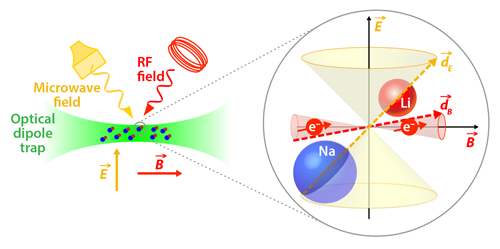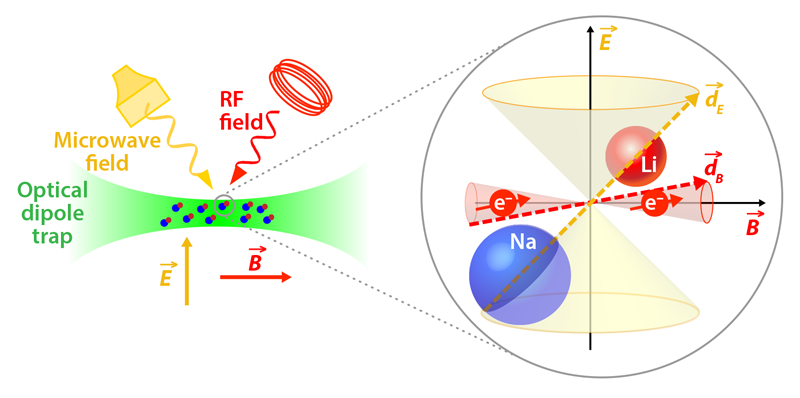A New Spin on Ultracold Molecules
For over a decade, researchers around the world have pursued the goal of producing molecular gases cooled to ultracold temperatures. The driving forces behind this pursuit are the new experimental possibilities that arise from the complexity of molecules as compared to atoms. Most prominently, heteronuclear molecules, which are made up of different atoms, have electric dipoles that offer an additional degree of control for applications such as quantum simulation and controlled chemistry. And some classes of heteronuclear molecules possess a magnetic dipole that offers another degree of control. But bringing such molecules into the ultracold regime has so far proved elusive. Now Timur Rvachov and colleagues from the Massachusetts Institute of Technology, Cambridge, report [1] the creation of an ultracold gas of fermionic molecules in an internal state that has both an electric dipole and a magnetic dipole (Fig. 1). Remarkably, when confined in an optical trap, the gas exhibits a long lifetime despite the molecules not being in their absolute ground state. These results open up new avenues of exploration in ultracold molecular chemistry, quantum control, quantum information, and quantum many-body physics [2].
Bringing molecules into the ultracold regime (typically within a millionth of a degree above absolute zero) remains a significant challenge. The direct laser-cooling techniques that are now widely developed for atoms do not straightforwardly apply to molecules because of their additional rotational and vibrational degrees of freedom. Although spectacular advances have been made recently with the laser cooling and trapping of molecules in magneto-optical traps [3–5], such direct cooling approaches have not yet succeeded in producing high-density ultracold molecular gases.
Ingeniously, however, researchers have instead learned to bond together precooled alkali-metal atoms, which can be readily cooled to ultracold temperatures, to form ultracold molecules [6–11]. This successful method exploits the existence of scattering resonances, known as Feshbach resonances, in the collisions between ultracold atoms in an applied magnetic field. Ramping the magnetic field across such a resonance results in the conversion of the free colliding atoms to weakly bound molecules, in which the atoms are far apart, without an increase in temperature. Such molecules can then be converted into strongly bound molecules, in which the atoms are held close together, using two optical fields in a process known as stimulated Raman adiabatic passage (STIRAP)—a transformation that is the equivalent of converting a whale into a flea. The two optical fields connect the huge weakly bound molecules to the tiny strongly bound molecules via a common “helper” electronic excited state. STIRAP then uses this helper state to coherently (and reversibly) transfer the weakly bound molecules to the strongly bound state, removing an internal binding energy that can exceed several thousand kelvin without heating the molecular gas. This approach was pioneered in 2008 for molecules [6] and KRb molecules [7], and it was later extended to RbCs [8, 9], NaK [10], and NaRb [11] molecules.
All of the above STIRAP-based experiments produce diatomic alkali-metal molecules in the absolute lowest rotational-vibrational (or rovibrational) state of their electronic ground state. Alkali-metal atoms have a single unpaired valence electron, and when forming diatomic molecules, the two electrons can either be paired to yield a total spin of 0 (a singlet state) or 1 (a triplet state). The lowest energy state of the molecule lies at the bottom of the singlet potential and does not have an electronic magnetic moment because the total electronic spin is 0. Therefore, all the heteronuclear diatomic molecules produced to date [7–11] only possess an electric dipole moment. By contrast, Rvachov and colleagues use STIRAP to transfer their NaLi molecules to the lowest rovibrational state of the triplet potential. This state has a magnetic dipole moment of 2 , where is the Bohr magneton, as well as an electric dipole moment of 0.2 D, where D is a debye, so that the molecule will couple strongly to both magnetic and electric fields (Fig. 1). A similar approach was taken in 2008 [12] using , but as this molecule is homonuclear, it only possesses a magnetic dipole moment and not an electric dipole moment.
One of the expected problems with molecules in the triplet state is that they have many potential decay paths, including chemical reactions, which limit their lifetime. However, Rvachov and colleagues investigate the lifetime of their molecules by confining them in an optical dipole trap, and they find that the molecules are remarkably long-lived. This is in part due to the fermionic character of the molecules that suppresses molecular collisions in the ultracold regime. Intriguingly, the low mass of the molecule (NaLi is the lightest heteronuclear bi-alkali molecule) might also play an important role in its long lifetime. It has recently been proposed [13] that the high density of states available in molecular collisions can lead to the formation of long-lived collision complexes, which in turn lead to enhanced loss of the molecules. Indeed, even chemically stable molecules in the singlet ground state have been found to exhibit relatively high loss rates [8–11]. As the density of states scales with the molecular mass, further experiments with NaLi molecules, which probe the low-mass regime, could provide insight into this loss mechanism.
The work of Rvachov and colleagues represents another important step in our quest to exert full control over ultracold molecules. Looking to the future, it will be fascinating to see what new experiments are enabled by the presence of an electronic magnetic moment. Confining such magnetic molecules in a magnetic (rather than optical) trap will remove sources of heating and loss associated with the trap light, and it will enable cleaner collision studies with atoms in which the internal state is more well defined. In turn, this may allow “sympathetic” cooling of NaLi molecules, through collisions with an ultracold atomic gas, into the quantum degenerate regime, in which the fermionic character of the molecules will dominate, and the gas will cease to behave according to the laws of classical physics. Such a system confined in an optical lattice would present a new kind of quantum simulator with applications in advanced quantum materials modeling and design.
This research is published in Physical Review Letters.
References
- T. M. Rvachov et al., “Long-Lived Ultracold Molecules with Electric and Magnetic Dipole Moments,” Phys. Rev. Lett. 119, 143001 (2017).
- L. D. Carr, D. DeMille, R. V. Krems, and J. Ye, “Cold and Ultracold Molecules: Science, Technology and Applications,” New J. Phys. 11, 055049 (2009).
- J. F. Barry, D. J. McCarron, E. B. Norrgard, M. H. Steinecker, and D. DeMille, “Magneto-Optical Trapping of a Diatomic Molecule,” Nature 512, 286 (2014).
- S. Truppe, H. J. Williams, M. Hambach, L. Caldwell, N. J. Fitch, E. A. Hinds, B. E. Sauer, and M. R. Tarbutt, “Molecules Cooled Below the Doppler Limit,” Nat. Phys. (2017).
- L. Anderegg, B. L. Augenbraun, E. Chae, B. Hemmerling, N. R. Hutzler, A. Ravi, A. Collopy, J. Ye, W. Ketterle, and J. M. Doyle, “Radio Frequency Magneto-Optical Trapping of CaF with High Density,” Phys. Rev. Lett. 119, 103201 (2017).
- J. G. Danzl, E. Haller, M. Gustavsson, M. J. Mark, R. Hart, N. Bouloufa, O. Dulieu, H. Ritsch, and H.-C. Nägerl, “Quantum Gas of Deeply Bound Ground State Molecules,” Science 321, 1062 (2008).
- K.-K. Ni, S. Ospelkaus, M. H. G. de Miranda, A. Pe'er, B. Neyenhuis, J. J. Zirbel, S. Kotochigova, P. S. Julienne, D. S. Jin, and J. Ye, “A High Phase-Space-Density Gas of Polar Molecules,” Science 322, 231 (2008).
- T. Takekoshi, L. Reichsöllner, A. Schindewolf, J. M. Hutson, C. R. Le Sueur, O. Dulieu, F. Ferlaino, R. Grimm, and H.-C. Nägerl, “Ultracold Dense Samples of Dipolar RbCs Molecules in the Rovibrational and Hyperfine Ground State,” Phys. Rev. Lett. 113, 205301 (2014).
- P. K. Molony, P. D. Gregory, Z. Ji, B. Lu, M. P. Köppinger, C. R. Le Sueur, C. L. Blackley, J. M. Hutson, and S. L. Cornish, “Creation of Ultracold Molecules in the Rovibrational Ground State,” Phys. Rev. Lett. 113, 255301 (2014).
- J. W. Park, S. A. Will, and M. W. Zwierlein, “Ultracold Dipolar Gas of Fermionic Molecules in Their Absolute Ground State,” Phys. Rev. Lett. 114, 205302 (2015).
- M. Guo, B. Zhu, B. Lu, X. Ye, F. Wang, R. Vexiau, N. Bouloufa-Maafa, G. Quéméner, O. Dulieu, and D. Wang, “Creation of an Ultracold Gas of Ground-State Dipolar Molecules,” Phys. Rev. Lett. 116, 205303 (2016).
- F. Lang, K. Winkler, C. Strauss, R. Grimm, and J. H. Denschlag, “Ultracold Triplet Molecules in the Rovibrational Ground State,” Phys. Rev. Lett. 101, 133005 (2008).
- M. Mayle, G. Quéméner, B. P. Ruzic, and J. L. Bohn, “Scattering of Ultracold Molecules in the Highly Resonant Regime,” Phys. Rev. A 87, 012709 (2013).





